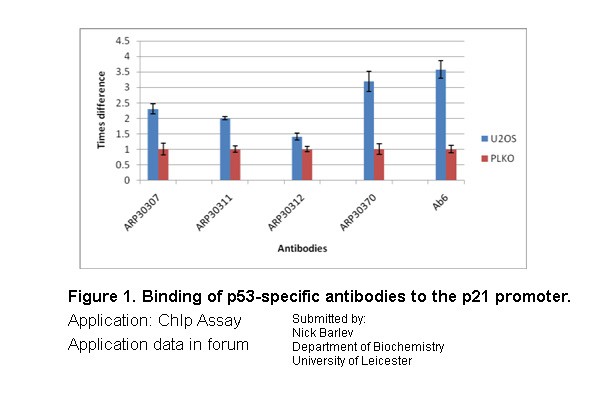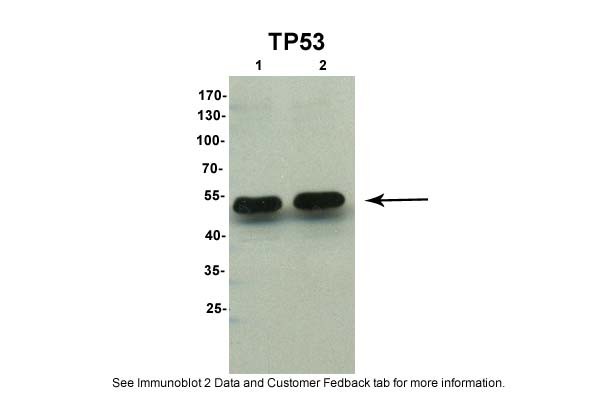TP53 antibody
| Product name: | TP53 antibody |
| Source: | Rabbit |
| Purity: | >95% |
| Buffer Formulation: | phosphate buffered saline , pH 7.4, 150mM NaCl, 0.02% sodium azide and 50% glycerol. |
| Applications: | WBChIP |
| Storage: | Aliquot and store at -20°C. Avoid repeated freeze / thaw cycles |
| UOM: | 100ug |
Rabbit anti-TP53 polyclonal antibody - N-terminal region
Catalog Number:IC105173
- 1
- 2
Product Profile
| ProductName | Rabbit anti-TP53 polyclonal antibody - N-terminal region |
|---|---|
| AntibodyType | Primary Antibodies |
| Immunogen |
The immunogen for anti-TP53 antibody: synthetic peptide directed towards the N terminal of human TP53 |
Key Feature
| Clonality | Polyclonal |
|---|---|
| Isotype | IgG |
| Host Species | Rabbit |
| Tested Applications | |
| Species Reactivity | |
| Concentration | 1mg/ml |
| Purification | Affinity purified |
Target Information
| Gene Symbol | TP53 |
|---|---|
| Gene Synonyms |
LFS1
TRP53 p53 |
| Gene Summary |
TP53 acts as a tumor suppressor in many tumor types; induces growth arrest or apoptosis depending on the physiological circumstances and cell type. Involved in cell cycle regulation as a trans-activator that acts to negatively regulate cell division by controlling a set of genes required for this process. This gene encodes tumor protein p53, which responds to diverse cellular stresses to regulate target genes that induce cell cycle arrest, apoptosis, senescence, DNA repair, or changes in metabolism. p53 protein is expressed at low level in normal cells and at a high level in a variety of transformed cell lines, where it's believed to contribute to transformation and malignancy. p53 is a DNA-binding protein containing transcription activation, DNA-binding, and oligomerization domains. It is postulated to bind to a p53-binding site and activate expression of downstream genes that inhibit growth and/or invasion, and thus function as a tumor suppressor. Mutants of p53 that frequently occur in a number of different human cancers fail to bind the consensus DNA binding site, and hence cause the loss of tumor suppressor activity. Alterations of this gene occur not only as somatic mutations in human malignancies, but also as germline mutations in some cancer-prone families with Li-Fraumeni syndrome. Multiple p53 variants due to alternative promoters and multiple alternative splicing have been found. These variants encode distinct isoforms, which can regulate p53 transcriptional activity.
More
|
| Alternative Names |
LFS1
TRP53 p53 |
| MolecularWeight(MW) | 44kDa |
| Sequence | 393 amino acids |
Database Links
| Entrez Gene | 7157 |
|---|---|
| SwissProt ID | P04637 |
| Protein Accession | NP_000537 |
Application
-

Chromatin Immunoprecipitation
U20S (p53+) cells were treated with 0.5 uM Doxorubicin for 14 hrs to induce DNA damage and hence activate p53. In parallel, PLKO cells (U2OS cells with stable shRNA-mediated knockdown of p53) were treated similarly and were used as negative control. Thedata for p21 promoter were normalised to actin (control for non-specific binding of DNA to the antibodies).
-

Western blot
0.2-1 ug/ml
ELISA Titer: 1:62500
Positive Control: 293T cell lysate -

Western blot
human cystic fibrosis bronchial epithelial cells
P53: 1/1 000Goat anti-rabbit-HRP: 1:5000
Additional Information
| Form | Liquid |
|---|---|
| Storage Instructions | Aliquot and store at -20°C. Avoid repeated freeze / thaw cycles |
| Storage Buffer | phosphate buffered saline , pH 7.4, 150mM NaCl, 0.02% sodium azide and 50% glycerol. |
Note: The product is for research use only,not for use in diagnostic or therapeutic procedures.













